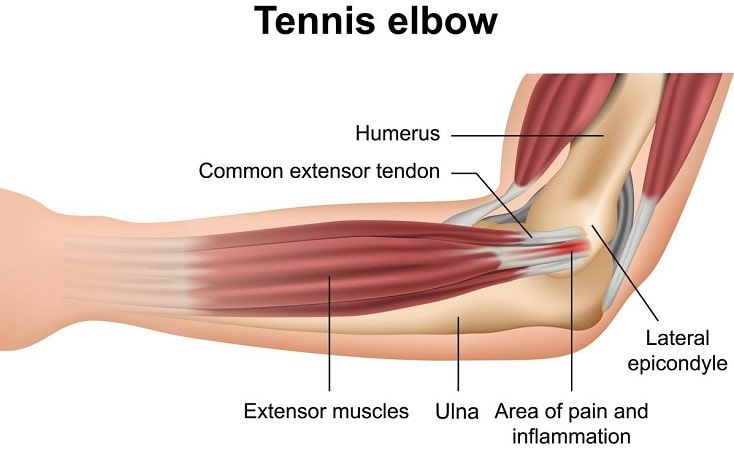Tennis Elbow
Tennis elbow is the common name used for the elbow condition called lateral epicondylitis. It is an overuse injury.
This painful condition occurs from repeated muscle contractions at the forearm that leads to inflammation and micro tears in the tendons that attach to the lateral epicondyle, on the outside of the elbow.
The condition is more common in sports activities such as tennis, painting, hammering, typing, gardening and playing musical instruments.
Patients with tennis elbow experience elbow pain or burning localised to the outer side near the lateral epicondyle and upper outer forearm. This pain is initially occurring whenever the forearm muscles are used for gripping things or carrying objects like shopping bags or frying pans. It gradually worsens and leads to a weakened grip.
Tennis elbow is primarily diagnosed based on patient’s history and clinical examination. Patients have tenderness near the lateral epicondyle on the outer aspect of the elbow or the upper forearm. Their grip is weak and painful.
Elbow x-rays may be normal or show some lateral calcification.
In rare cases an MRI is needed to confirm and assess the severity of the tennis elbow. Nerve conduction studies (NCS) or electromyograms (EMG) may be needed to rule out nerve compression at the elbow.
The treatment options available for treating tennis elbow are non-surgical (conservative) and surgical.
All patients are first recommended conservative treatment options to treat the tennis elbow symptoms. These may include:
- Limit use and rest the arm from activities that worsen symptoms.
- Splints or braces may be ordered to decrease stress on the injured tissues.
- Apply ice packs and painkiller gels on the elbow to reduce swelling and pain.
- Avoid activities that bring on the symptoms and increase stress on the inflamed tendons. Lifting, pushing or carrying heavy objects in the affected hand is avoided.
- Anti-inflammatory medications are prescribed to reduce pain and swelling.
- Physiotherapy may be ordered for strengthening and stretching exercises to the forearm once initial painful symptoms have decreased.
- Pulsed ultrasound may be utilized to increase blood flow and promote healing to the injured tendons.
- In cases failing to respond to above measure by 6 to 12 weeks, surgeons can give a steroid injection into the painful. This helps reduce inflammation, pain and swelling. Though these are cheaper, some patients develop hypo-pigmented (white) patches at the injection site that may take 4 to 6 months to settle down. This creates unwanted patient anxiety during treatment.
- Platelet rich plasma (PRP) injections are now popular and widely used. They have growth factors that assist in healing of the inflamed tendon.

Surgical options are recommended if the conservative treatment options fail to resolve the condition and symptoms persist beyond 6 -12 months.
Surgeons will recommend a surgical procedure called lateral epicondyle release surgery (release of tennis elbow). The goal of surgery to treat Tennis Elbow is to remove the diseased tissue around the outer elbow, improve blood supply to the affected area, to promote healing, and alleviate the patient’s symptoms.
This surgery can be done either by open technique or arthroscopically.
Dr Jadhav will decide which options are best for you depending on your specific circumstances. He performs these surgeries by both methods depending upon patient’s affordability.
Surgeons move aside soft tissue to view the affected extensor tendon and its attachment on the lateral epicondyle. Then they trim the tendon or release the tendon and then reattach it to the bone. Any scar tissue present will be removed as well as any bone spurs. After the surgery is completed, the incision(s) are closed by suturing or by tape.
Patients are given anti-inflammatory painkillers and asked to do daily ice-packing for 4 to 5 times. They are also sent for elbow physiotherapy which is performed as tolerated. This helps in improving the elbow range of motion, muscle strength and function.
Book An Appointment
Private Clinics : Locations & Directions
London Joints Clinic (Pune)
Address
Office S 5, 2nd Floor, North Block, Sacred World Mall,
Opp Sacred Heart Township, Near Jagtap Chowk,
Wanawadi, Pune 411040
Monday, Wednesday & Friday 7 PM to 9 PM
Sunday 11 AM to 1 PM
Appointments
London Joints Clinic ( PCMC )
Address
C/O Dr Nitin’s Physio Clinic,
Opp. Brahma Hotel,
Near Akurdi Post Office,
Vivek Nagar,
Akurdi,
Pune 411035
Saturdays only 4.30 PM to 7.30 PM
Appointments
Hospitals OPDs : Locations & Directions
Manipal Hospital

Address
Manipal Hospital, Opp D Mart, Baner-Mhalunge Road, Baner, Pune 411 045
Monday to Saturday 11 AM to 4 PM
Appointments
Contact us
Dr Anand Jadhav has a centralised appointment system for all locations across various hospitals and clinics in Pune & PCMC areas
Appointment Bookings & Requests can be made by any method :

